
The 1995-96 Governor's Budget includes a realignment proposal which would increase county funding responsibility for the Aid to Families with Dependent Children (AFDC) Program and for several children's services programs. Most of the additional county costs would be offset by increasing the state share of the trial court program and by a transfer of sales tax and trial court revenues to the counties.
The Governor's proposal is similar in some respects to a restructuring proposal offered by this office in 1993. The Governor's proposal, however, is narrow in its focus and asserts that shared interests justify extensive sharing of program responsibilities. In contrast, our Making Government Make Sense proposal focused on the broad structure of the state- county relationship and sought to maximize separation of responsibilities to enhance accountability.
As an initial step in achieving a better state/county partnership, the Governor's proposal is, in our judgment, seriously flawed because it exacerbates budgetary pressures on county governments while giving the counties few tools with which to control costs and guide local destinies. One portion of the proposal, however, relating to the realignment of children's services programs, does have considerable merit and we believe that it should be seriously considered by the Legislature.
To assist the Legislature in crafting a plan of action for 1995-96 which will move the state towards the critical objective of restructuring California's dysfunctional system of government, we outline the elements of the Governor's proposal and evaluate its fiscal implications for both the state and the counties. In addition, we suggest ways in which the proposal for realignment of children's services programs could be improved.
The relationship between the state and local governments has been characterized by considerable tension in recent years. Although these tensions were present even before the passage of Proposition 13, they have been exacerbated by a more restrictive fiscal environment and an increasing tendency towards state control of programs and services. The property tax shifts of the last three years have further reduced the fiscal capacity of local governments, especially counties, and there is a growing recognition that the existing relationship between the state and local governments must be changed.
In The 1993-94 Budget: Perspectives and Issues we reviewed the problems that characterize California's dysfunctional system of state and local government. We offered a set of principles to guide the state's efforts to address this problem, and presented a proposal for restructuring the state and local government relationship. Our Making Government Make Sense model generally urged a greater separation of state and local government program responsibilities and funding sources, in order to promote both greater innovation and accountability for program results. It advocated a three-step process for restructuring the state and local relationship, beginning with an examination of the assignment of governmental responsibilities for program control and delivery of services. This would be followed by changes in the allocation of resources to support the changes in assignment of program responsibilities, and the establishment of incentives and sanctions to promote the achievement of public goals. This proposal contributed to a broader discussion of the role of governmental structure in achieving higher levels of governmental effectiveness, but did not result in any legislative action.
In the following year, the 1994-95 Governor's Budget contained a new proposal for governmental restructuring. Aimed primarily at the state-county relationship, the proposal sought to increase county shares of cost in existing health and welfare programs, and balance these increased costs with increased revenues transferred to counties from the state. The proposal would have resulted in a greater decentralization of programs and funding relative to what exists today, and in this sense moved in the same direction as our Making Government Make Sense proposal. The proposal's assertion that shared interests justified extensive sharing of program responsibilities marked the major area of difference with our earlier proposal. In addition, the discussion of changes in the state-local relationship has been receiving considerable attention on other fronts within the state. The Constitutional Revision Commission created by Ch 1243/93 (SB 16, Killea) is in the process of preparing a proposal for constitutional reform, and changes to the state-local relationship are expected to occupy a major portion of its effort. The Commission plans to issue its first report in August 1995. Any of its proposals accepted by the Legislature would appear on the statewide ballot during 1996. Other organizations, such as the California State Association of Counties and the League of Cities, have prepared major working papers on the topic. In addition, a coalition of non-public sector organizations has engaged in a consensus project on this topic with the assistance of academic sponsors.
Recent discussions at the federal level could lead to a reshaping of the federal- state partnership and in turn continue the momentum for state-local restructuring. Recent federal proposals could dramatically increase the ability of states to design their own approaches to the administration of social services programs. If enacted, these proposals, at a minimum, could eliminate some of the perceived obstacles to the state-local restructuring proposals that have been discussed in the past. More positively, they also could encourage the consideration of new approaches to collaboration in service delivery.
These developments appear to indicate that there is a significant opportunity to make changes to the state-local relationship in the coming year. The administration has presented its second proposal for restructuring in The 1995-96 Governor's Budget, and this report presents our analysis and evaluation of its viability. In general, we conclude that the Governor's proposal fails to address many of the serious problems facing California in the years ahead, and does not take advantage of the opportunities that are present today. In our view, the Legislature should recognize the changing context and fiscal resources of governments at all levels as it fashions its own course of action for 1995.
The 1995-96 Governor's Budget contains a proposal for restructuring the relationship between county governments and the state. Borrowing significantly from the approach used in the 1991 state-county program realignment, this proposal increases county shares of cost in existing social services programs, and balances most of these increased costs with (1) increased revenues transferred to counties from the state and (2) increased state share-of-cost in other programs.
In this report, we review the Governor's proposal and its fiscal implications. In addition, we discuss our concerns with the proposal. We make recommendations about which portions of the proposal should be seriously considered by the Legislature, and which portions of the proposal should be rejected because they serve to exacerbate underlying problems in the state/county relationship.
Figure 1 illustrates the shifts in financial responsibility and funding associated with the Governor's proposal. As the figure shows, the administration's estimates indicate that counties would face increased costs of approximately $1.9 billion in a variety of social services programs. These costs would be offset by increased county resources amounting to $1.6 billion, resulting in a net cost to the counties (and savings to the state) of $241 million. To compensate the counties, the Governor proposes legislation to abolish the state mandate for General Assistance, as well as relief from state mandates in the indigent health, public health and mental health programs.
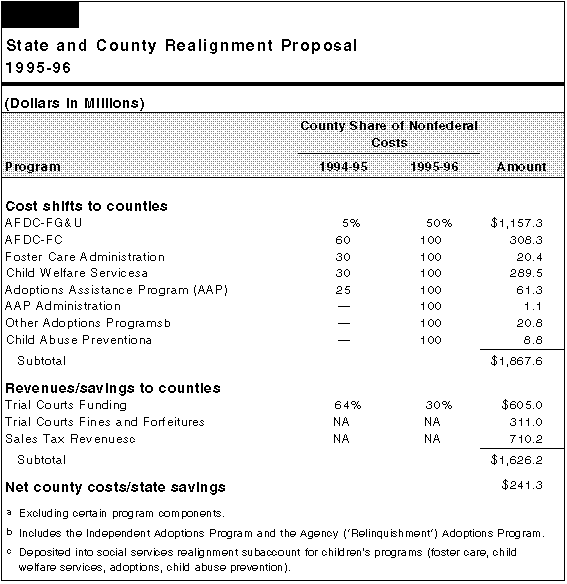
These elements of the proposal are described in more detail below.
Counties to Take Over Social Services Programs. Under the administration's proposal, complete financial and program responsibility for the Foster Care, Child Welfare Services (CWS), adoptions, and child abuse prevention programs would be transferred to the counties. Counties would have discretion to determine service levels and approaches to service delivery (within the constraints of federal regulations), and the involvement of state agencies in these program areas would be limited. These program transfers reflect a recognition of the linkages that exist among these and other community-based services. By allowing counties greater flexibility in the operation of these programs, the administration expects the results to be a service delivery system which is more callaboratively innovative and outcome- based.
Increased State Funding for Trial Courts. Under the proposal, the state would significantly increase its funding for trial courts within the existing Trial Court Funding (TCF) Program. The administration proposes that the state funding level be increased to 70 percent of total statewide trial court operations expenses, corresponding to the level intended by current statutes. This portion of the proposal reflects the view that a greater state share of costs is consistent with the statewide interest in promoting the uniform application of justice throughout the 58 counties and recognizes that trial court operations are controlled primarily by state laws and regulations.
Court-Related Fine and Penalty Revenues Returned to Counties. The proposal would return the state's share of local trial court-related fine and penalty assessment revenues (about $311 million) to counties. The return of these trial-court related revenues is intended to improve local incentives to collect these funds, which has been a problem over the entire period that local governments have been required to remit these funds to the state.
Increased Sales Tax Allocations. The proposal would increase allocations of state sales taxes to the counties. This would be accomplished by earmarking a portion (.2215 cent) of the state's sales tax to pay for the increased county costs of the foster care, CWS, adoptions, and child abuse prevention programs.
Under the proposal, the increased sales tax revenue would be combined with existing realignment revenues allocated to the foster care and CWS programs and deposited into a new Children's Services Subaccount within the Realignment Account for the counties. This would give counties greater flexibility in the use of these funds for the programs covered. For example, counties would have the ability to use part of their foster care allocation for preventive CWS activities such as family preservation.
The Governor's 1995-96 restructuring proposal also includes proposed legislation to provide mandate relief to counties. Under the Governor's plan, mandate relief would be provided by (1) allowing counties broad control over the General Assistance program and (2) reducing maintenance of effort (MOE) requirements for indigent, public, and mental health programs. The purpose of this mandate relief is to provide counties with a means of offsetting the net cost of $241 million resulting from the realignment of AFDC program expenditures and the TCF Program.
General Assistance. The Governor proposes major changes in the General Assistance (GA) Program, including proposals to:
Relief from Maintenance-of-Effort Requirements. The Governor also proposes to give counties greater flexibility in funding decisions with respect to indigent, public, and mental health expenditures. Specifically, the Governor proposes to:
Our review of the proposal's fiscal implications is primarily intended to address the question of the proposal's fiscal impact on the counties, both in the immediate 1995-96 time frame and through the remainder of this decade. We discuss the likely cost and revenue trends under two scenarios. We also discuss certain other issues that may affect the fiscal impact of the proposal.
From the county perspective, this conclusion is, however, dependent upon the budget's assumptions that there will be significant savings from several major policy proposals and assumptions, including increased federal funds in the AFDC Program and the adoption of grant reductions (please see Part IV of this volume for a detailed description of these proposals). This is because the estimates of increased county shares of cost under the proposal are based upon the budget's estimates of total program costs, which reflect these savings. To the extent that these assumptions are not realized--for example, the increased federal funds are not forthcoming and the grant reductions are not adopted--we estimate that the level of costs transferred to the counties would be up to $161 million higher than shown above.
Similarly, the budget assumes significant savings in AFDC grants resulting from more efficient county administration of the program, due to (1) the increased incentive for counties to reduce program costs as a result of giving counties a higher share of these costs and (2) a proposed General Fund augmentation of $20 million for counties to implement unspecified projects in administering the program. To the extent that the assumed savings do not materialize, actual program costs transferred to the counties would be up to $58 million higher than anticipated in the budget. (We discuss this proposal in more detail in our analysis of the AFDC Program in the Analysis of the 1995-96 Budget Bill.)
Figure 2 summarizes the fiscal impact of the budget's assumptions on county costs in 1995-96. Because it is unlikely that all of the savings from policy changes and federal actions will be realized, the proposal's assertion of a $241 million gap is a tenuous one, and the actual gap represented by the restructuring proposal could be much larger.
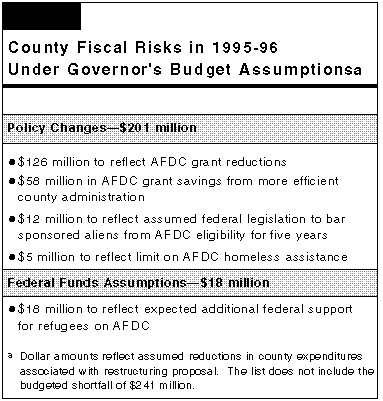
The Legislature could make adjustments in the level of resources it provides to the counties to account for action it takes on the state's budget. However, in the case of the anticipated federal funds, it is unlikely to have any firm basis on which to proceed because federal budget actions will not be finalized until September or October of this year. Similarly, it will not be known to what extent the counties can achieve the assumed savings from more efficient administration of the AFDC Program until well into the budget year.
Currently, the Trial Court Budgeting Commission (TCBC) is responsible for allocating state funding among the trial courts. Although the Budget Bill, as proposed, reflects continuation of this arrangement, the administration indicates that it will hold discussions with the TCBC and the Judicial Council regarding the ultimate scope of the state's responsibilities for supporting trial courts and the method for allocating state funds based on those responsibilities. Thus, at this time it is unclear how the increased Trial Court Funding support would be allocated among counties. Without this information, we are not currently able to fully evaluate the proposal on a county-by-county basis. We note, however, that there are likely to be uneven impacts on counties, particularly in the relationship between the increased costs for the AFDC Program and the increased resources due to shifts in the Trial Court Funding Program.
More Losers than Winners Can Be Anticipated. Because counties vary widely in the costs of court operations relative to the costs of AFDC within the county, the effects of the Governor's proposal on counties will vary widely as well. Moreover, some counties would benefit more from proposed AFDC program changes than would other counties, depending on the underlying demographics of the welfare population within the county. Thus, in counties where the AFDC Program expenditures are high relative to the size of the TCF Program, there will be a realignment gap under the Governor's proposal. Conversely, and notwithstanding the statewide gap of $241 million, in counties with court costs that are disproportionately high relative to the county's AFDC caseload, it is possible that the proposal would result in a fiscal gain. While sufficient information is not currently available to fully assess the county-by-county impacts of the Governor's proposal, certain data that are available suggest that the proposal to swap trial court funding for a greater county share of AFDC program costs cannot be made fiscally neutral, at least for some counties, even if the state were to fund more than 70 percent of the TCF Program.
For example, we estimate that if both the Governor's current realignment proposal and the 7.7 percent AFDC grant reductions had been implemented for 1994-95, Merced County's AFDC costs would have increased by $14.1 million, while its trial court costs would have decreased by $4.6 million--a gap of $9.5 million. Even if the Governor's proposal ultimately allowed for Merced County to pay none of its trial court costs, a gap totalling $7.2 million between the county's AFDC costs and TCF program savings would still exist.
In fact, our preliminary review of county costs in both the AFDC and the TCF programs suggests that in the short run significantly more counties are likely to experience net increased costs from the swap than are likely to benefit from net savings. This is particularly true if major program reductions are not adopted in tandem with the proposed swap.
Our analysis indicates that the statewide county gap of $241 million in 1995-96 could become a small surplus (roughly $100 million) to counties by the end of the decade. This surplus would occur, however, only if (1) all of the Governor's proposed welfare reforms were adopted, (2) increased federal funds become and remain available as proposed in the Governor's Budget, (3) the economy grows at a steady pace, and (4) the state takes no action to curtail the current underlying growth rate in court costs, despite its assumption of an increased share-of-cost. Moreover, the mismatch between AFDC grant costs and court costs is so striking in some counties that we believe that despite this small statewide surplus, there would continue to be deficits in some counties. Thus, even under the most optimistic scenario, some counties would likely continue to lose under the Governor's realignment proposal. Preliminary data suggest that these losses would be concentrated in the Central Valley counties because they tend to have AFDC costs that are higher relative to their trial court costs.
In contrast, if the Governor's welfare reform package is not adopted, the statewide gap in county resources under the Governor's proposal could be about $300 million by the end of the decade. This projection assumes that the shift of the state resources to counties is increased to balance the higher county AFDC costs resulting from not adopting the Governor's proposals.
As indicated above, the preliminary data show that (1) more counties would be losers than winners in the short-run under the current restructuring proposal and (2) the long-term impact on counties depends largely on implementation of welfare reform and the underlying growth rates in trial court costs. Moreover, it is possible that even when counties on a statewide basis are in the black , a significant number of counties would continue to run deficits as a result of the wide variation in AFDC and court costs at the county level.
Counties' Fiscal Condition Is Deteriorating. Our review of current county fiscal condition, however, suggests that all counties are under unprecedented budgetary pressures as a result of (1) the long-term effects of the recent recession, (2) permanent state transfers of property tax revenues to schools, and (3) underlying slow-growth in county revenue sources relative to growth in demand for county services.
General Fiscal Condition Affects Program Management Decisions and Long-Term Policy Choices. Because of (1) the negative impact the AFDC- TCF transfer is likely to have on most counties in the short-run, and (2) counties' generally poor fiscal condition, counties would be under extreme budgetary pressure to maximize short-run savings and minimize short-run costs under this proposal. As a result of this fiscalization of policy decisions, counties may not make wise programmatic decisions concerning such things as front-end investment in long-term preventive measures designed to get recipients off welfare and keep them off. This in turn could have long-term impacts on program costs at both the state and local level.
As we discuss below, these fiscal constraints would place considerable pressure on counties to reduce or eliminate their General Assistance Program, as would be permitted under the Governor's proposal.
The estimated county shortfall of $241 million in the Governor's proposal establishes a potential state liability for unfunded mandates on local governments. It is not clear, at this time, that the proposed mandate relief provisions would absolve the state of this obligation. Also, to the extent that the budget's assumptions regarding federal funds and program reductions are not borne out, or if revenue growth in future years is not sufficient to offset program cost growth, the state could be liable for reimbursement of the excess costs faced by the counties.
At the outset, the Legislature should recognize that the Governor s proposal is but one of many different courses of action it could choose to begin the process of restructuring the state-local relationship. The Legislature s own realignment task force last year considered many of these options, and although it took no action, its work identified a wide range of programs and approaches under which an initial step towards its restructuring goals could be taken. Figure 3 identifies the programs that have been considered in the realignment context over the last two years, along with the 1995-96 fiscal impact of these changes on the state and the counties.
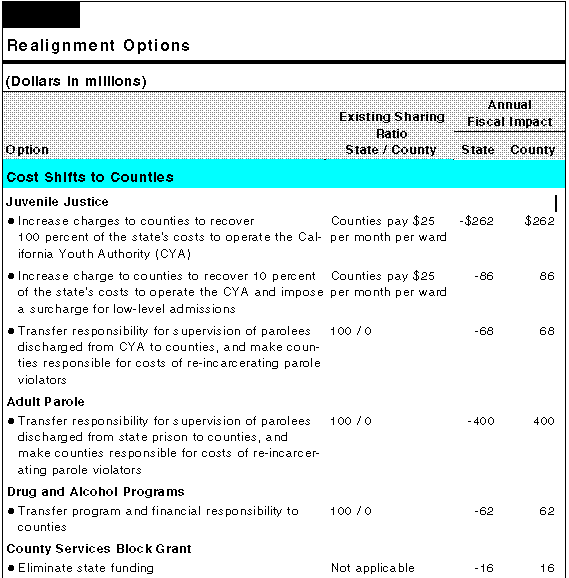
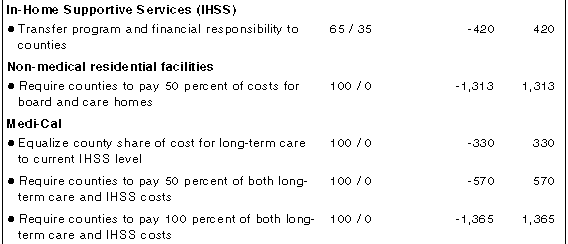
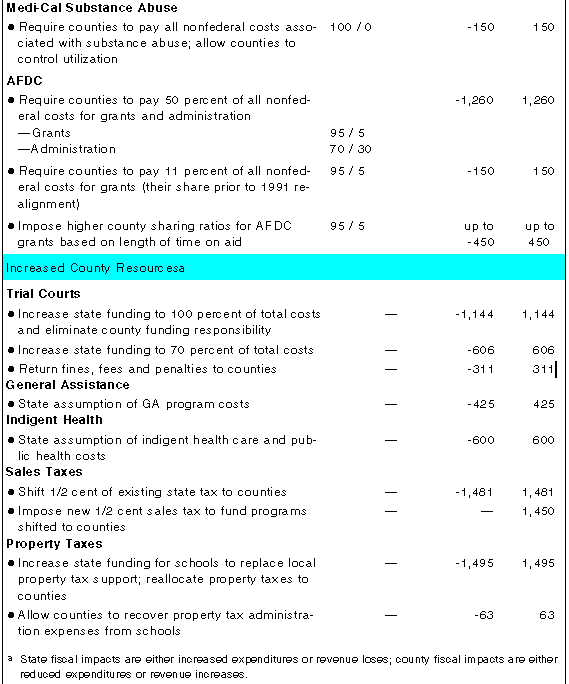
As we discussed in our Making Government Make Sense report, we believe that it is appropriate for the Legislature to evaluate the full range of existing state and local government responsibilities to determine whether changes in the existing assignment of responsibilities could improve the delivery of program services. However, we also recognize that the Legislature may find it necessary to implement changes in an incremental fashion over time. The key to such an approach is having a clear sense of the ultimate objective. Otherwise, policies initiated one year may be reversed the next. The listing of options presented in Figure 3 is intended to facilitate the Legislature s consideration of changes that could be implemented in the budget year recognizing the importance of beginning the restructuring process as soon as possible.
The Governor's 1995-96 realignment proposal has some commonality with the principles that we offered in our Making Government Make Sense model. The thrust of the proposal seeks to refocus important parts of the state-county relationship towards achievement of better outcomes. It attempts to improve those outcomes through reliance on fiscal incentives to motivate greater program performance. It also recognizes the need for more flexible approaches to service delivery, and promotes collaborative efforts among programs in delivering services to clients.
In our view, however, as a short-term or initial step towards making the longer term changes that are needed in the relationship between the state and all units of local government, the proposal is seriously flawed. This is because, taken as a whole, it exacerbates budgetary pressures on county governments while giving the counties few tools with which to control costs and guide local destinies. One portion of the proposal, however, relating to the realignment of children s services programs, does have considerable merit and we believe that it should be seriously considered. In addition, we believe that the Legislature should consider alternative approaches to the proposed AFDC-Trial Court Funding program swap, and that the issue of mandate relief should be considered on its merits outside of the general debate on the issue of program realignment. Our recommendations are summarized in Figure 4 and are discussed in more detail in the remainder of this analysis.
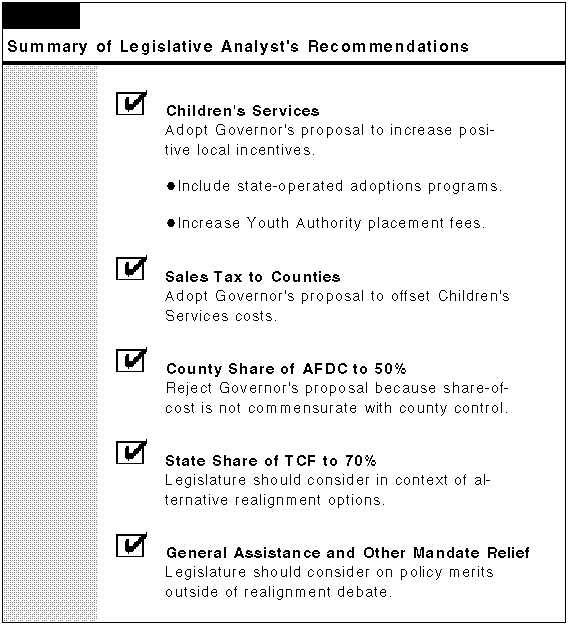
Under the Governor's proposal for realigning children's services, the counties would assume full financial responsibility for foster care, child welfare services, and most components of the adoptions programs. The proposed shift of foster care funding responsibility has merit because it would give the counties a strong fiscal incentive to focus on activities designed to reduce the need to place children in foster care arrangements.
We believe the Governor's proposal is reasonable. Assigning full financial responsibility to the counties recognizes the linkage between CWS and foster care, encourages accountability by clarifying governmental responsibility for the program, and still gives counties an incentive to invest in the preventive kinds of CWS activities because of the relatively high cost of foster care. Similarly, assigning counties full responsibility for the adoptions programs recognizes the linkage between these programs and foster care, and is consistent with the way the programs are currently administered in many counties.
In summary, we believe that the realignment of these children's services programs would result in greater accountability for program outcomes and provide more incentive to operate them on a cost-effective basis. We believe, however, that several modifications should be made to the proposal to improve it.
State Administered Adoptions Should Be Included in Proposal. The Governor's proposal did not address those adoptions programs where counties have decided to turn the program over to the state for administration (an option available to the counties under current law). According to the administration, this omission was inadvertent. We believe that, from a policy standpoint, there appears to be no reason to have a bifurcated program under the Governor's proposed realignment of responsibilities. Accordingly, we recommend transferring the state- operated programs to the counties ($4.6 million) as part of the realignment, and adjusting the amount of sales tax transferred to counties to reflect these increased costs.
Youth Authority Placement Incentives Need Correction. The Governor's proposal ignores fiscal incentive problems associated with two of the major treatment choices for juvenile offenders--foster care and the Youth Authority. In fact, the Governor's proposal may significantly worsen an existing counter- productive fiscal incentive. This is because it would increase the counties' cost for foster care placements while maintaining an extremely low county share of cost for Youth Authority placements. There are currently 5,000 juveniles on probation who have been placed in foster care, most of whom are placed in group homes costing an average of $3,100 per month. Under the proposal, counties could place these probationers instead into the Youth Authority, for which the counties are charged $25 per month per ward. The Governor's proposal contains no provisions requiring the maintenance of juvenile probationers in their existing placements, nor does it otherwise constrain a county's ability to transfer these persons to the CYA. By making such transfers, counties could avoid foster care placement costs, while shifting costs to the state.
In order to correct for this problem, we recommend that the cost faced by the counties for CYA placements be increased. From our perspective, charging the counties a fee similar to the cost of a group home placement for additional CYA placements would ensure that these decisions continue to be based primarily on treatment requirements.
AFDC. In order to give counties a greater incentive to pursue strategies that keep people off of AFDC, the budget proposes to increase the counties' share of the nonfederal costs of the program from 5 percent to 50 percent. We are concerned that the proposal would give counties a share of cost that is not commensurate with their ability to control program costs and which could threaten counties' financial stability during periods of economic downturn. This is because the bulk of expenditures for AFDC is driven by economic and demographic factors which counties have limited ability to influence. (This is not to say that counties have no ability to influence program costs, but their influence is of a far more marginal nature than that assumed by the Governor's proposal.)
Trial Court Funding. As discussed earlier, the Governor's proposal would significantly increase the state's share of funding for the trial courts, consistent with Ch 90/91, the Trial Court Realignment and Efficiency Act of 1991 (AB 1297, Isenberg). That act expressed legislative intent to increase state support of the trial courts each year to a maximum of 70 percent by the 1995-96 fiscal year.
We agree with the administration that the courts represent a truly statewide function, and the state has a strong interest in promoting uniform access to justice. In addition, greater state funding is justified on the basis that the state exercises primary control over trial court procedures and appoints the judges.
However, the Governor's proposal leaves open the question of what the state's ultimate objective is for funding and operation of the trial courts. This question has important implications for the Legislature. Specifically, if the Legislature wishes to significantly increase state funding for the trial courts, it will be important for the state to have greater involvement and control over trial court expenditures. Thus, we believe that the Legislature should first determine its ultimate funding objective for support of trial courts and the time period in which it wishes to achieve that objective.
After making these determinations, the Legislature should exert its influence to control trial court expenses and bring about operational efficiencies. This can be accomplished in a variety of ways. For example, the Legislature could provide for the allocation of trial court funds based on performance criteria, such as courts' ability to meet administrative cost-reduction goals and implement certain efficiency measures. The Legislature could also require superior and municipal courts in the same county to coordinate or unify their support services in order to take advantage of economies of scale.
In our view, if the Legislature does not wish to become involved in exercising more control over trial court operating costs, it makes little sense to purchase an increased share of trial court costs. This is especially true if the Legislature wishes to create new trial court judgeships in the coming years, which could increase trial court operating costs substantially.
Governor's AFDC/TCF Proposal Would Make County Fiscal Problems Worse. We find that the Governor's proposal to increase the state's share of trial court costs would not fully offset the transferred AFDC costs, particularly in the near term and would exacerbate pre-existing county fiscal capacity problems.
Consequently, we recommend that the Legislature reject the AFDC/TCF realignment at this time. Such a realignment of responsibilities should only be undertaken after the Legislature develops strategies concerning (1) overall county fiscal capacity, (2) appropriate partnership shares for AFDC and (3) long-term objectives for the financing of trial courts.
Alternatives to the AFDC Swap. If the Legislature makes the long-term decisions regarding the financing of trial courts and wishes to increase state support of trial courts, we suggest that it consider shifting fiscal responsibility for programs other than AFDC to the counties. As discussed earlier, Figure 3 summarizes the other program realignment options that have been identified in the last two years and could be matched with a trial court finding proposal. In evaluating the appropriateness of these other options, the Legislature should consider their long- term impacts on the state and counties.
As indicated above, the proposal's lack of fiscal neutrality represents a potential state liability as an unfunded mandate. We are also concerned that tying the shortfall to specific mandate relief provisions acts as a fiscal incentive for counties to make certain programmatic decisions without due consideration for the underlying reasons that caused the state originally to establish the GA Program requirements. Furthermore, the proposed changes in the GA Program could result in widely differing grant levels among the counties, leading to problems of inter-county migration, thereby encouraging counties to further reduce or eliminate the program. The resulting loss of income to recipients could have significant adverse impacts--on recipients' health, for example--which could lead to additional costs to the state and the counties. These potential consequences of abolishing the state mandate for GA are too important to be cast as a budget-balancer in the current realignment debate. Rather, the pros and cons of maintaining or eliminating the GA--and at what level of government--should be discussed on their own merits.
The need to begin serious efforts to restructure California's dysfunctional system of government is a critical one, and it is important that steps be taken during 1995 towards achieving this objective. At a minimum, the Legislature should take action this year to lay the long-term foundation for progress. In our view, real progress can be made only when both the state and county governments can enter a program partnership on a solid fiscal base. Toward this end, the Legislature needs to consider changes that improve, not worsen the fiscal capacity of county governments. Because of their weak fiscal condition, counties will face pressure to make program investment decisions based more on short-term fiscal considerations as opposed to the potential for improved long-term outcomes.
With the exception of the Children's Program realignment, the Governor's proposal would serve to put increased fiscal pressure on counties, thereby further fiscalizing many policy decisions at the local level. The Governor's proposal would have unequal impacts across counties, and would hurt more counties than it would help. Moreover, the Governor's proposed increased county share-of-cost for AFDC grants does not reflect the level of control that counties can reasonably be expected to exert over AFDC program costs.